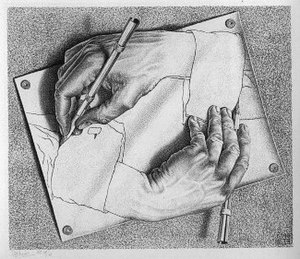
Strange loops can be many things, including musical tones, mathematical problems, and linguistic riddles. They also can be biological fact, and this fact might be translated into computer code or silicon chips. Here's why a philosophical theory might show true artificial intelligence is possible.What Are Strange Loops?When following a simple loop, you know you will go on a single trip that takes you back to where you started. There's one journey, and one destination. Strange loops are a bit more complicated — they form a kind of set of instructions, an ordered hierarchy, that brings you higher and higher, until you're back at the beginning where you started.Strange Loops were the brainchild of Douglas Hofstadter, a philosopher and scientist who wrote I Am a Strange Loop. They can be simple or complex, but they depend on what Hofstadter called "tangled hierarchies." Instead of a linear progression, these hierarchies balance on each other. Together they encompass a set of instructions that set out two equally valid ways of looking at a situation. The situation cannot be resolved without elevating one view and one part of the set of instructions over the other, but there is no objective way to do that.Examples of Strange LoopsHofstadter proposes the Mona Lisa, or any painting, as an example of a strange loop. It's a group of pigments that are spackled onto a canvas, and it's a smiling woman. Obviously one is literally true and one is only figuratively true, but one would have to be deliberately obtuse to talk of the painting as only a grouping of colors under varnish. Examples of strange loops within paintings are the famous impossible object images of M. C. Escher and others — the endlessly descending stairs and rigid cages with bars that cross each other. If we could pin down which part of the object was real we could decide which part violated the laws of that painting's universe, but there's no objective basis to declare one part of the image real rather than any other part.The Shepard Tones comprise a musical strange loop. They are a group of tones that seem to continually rise (or fall) but never actually change. Our attention focuses on certain notes that seem to rise, but the lower notes never drop out. We keep waiting for an impossibly high dog whistle that never comes.
Previously on the Strange Loops Channel (Feb. 2012):There are also linguistic strange loops that require us to make impossible distinctions. There's the famous two-sentence problem: "The following sentence is a lie. The previous sentence is true." And then there's the Berry Paradox, a famous mathematical definition that invalidates itself. It is meant to describe "the smallest positive integer not definable in under 1 words." Of course, whatever integer that is, it is now definable in under 11 words. Meaning there can't possibly be a smallest possible integer definable in under 11 words, except there has to be so that phrase can define it.Strange Loops and Artificial IntelligenceWhat does any of this word play have to do artificial intelligence? Hofstadter meant the title of his book literally. When he said, "I am a strange loop," what he meant was the idea of "I," the concept of the self, was a result of this weird duality of tangled hierarchies. Ask people if their brains, the actual electrically lit-up matter that sits in their head cases, are what what make them themselves, and they'll probably say yes. We are our brains. Ask them if they are simply a mechanical thing, programmed to respond to stimulus, like a complex adding machine, and they would say no. We have a sense of self. To take the strictly literalist view that we do not have selves, that we are mechanical, would be as obtuse as saying the Mona Lisa is a group of colors or a difference engine is a proto-human. Our electrified protein has constructed a more numinous identity, and both the meat and the idea are valid....MORE
Climateer Headline of the Day: Strange Loops Edition
First, a quick definition from Wolfram Math World:
A strange loop is a phenomenon in which, whenever movement is made upwards or downwards through the levels of some hierarchical system, the system unexpectedly arrives back where it started. Hofstadter (1989) uses the strange loop as a paradigm in which to interpret paradoxes in logic (such as Grelling's paradox, the liar's paradox, and Russell's paradox) and calls a system in which a strange loop appears a tangled hierarchy....Here's a graphic example of a strange loop:
Drawing Hands M.C. Escher, 1948
And here's FT Alphaville:
Rally Monkey gets sucked into the self-referential vortex of psychologically important thresholdsCue the already-deflating* bubble in a) people pointing out that the Dow hit 13,000, then b) people who point out the irrelevance of the Dow’s crossing 13,000, followed by c) people who get annoyed at people who point out the irrelevance of the Dow’s crossing 13,000 because it’s so bleeding obvious, which of course then leads to — oh hell, never mind....MORE
